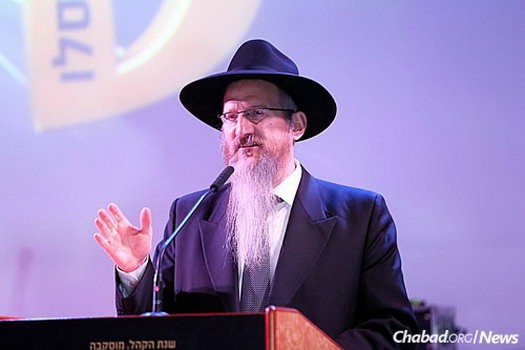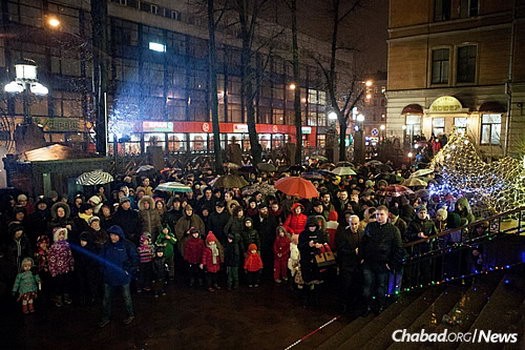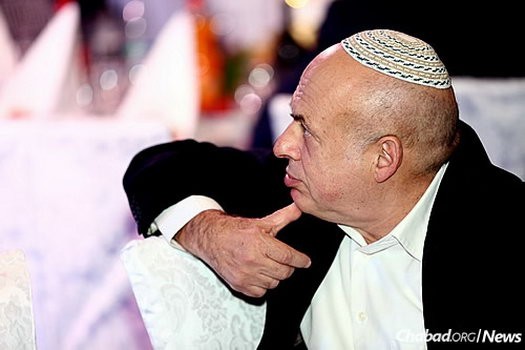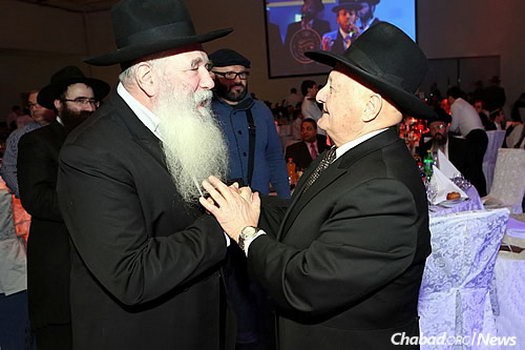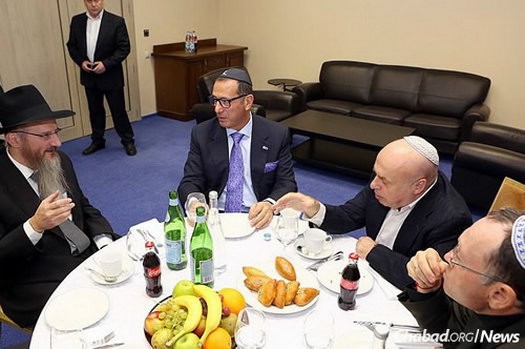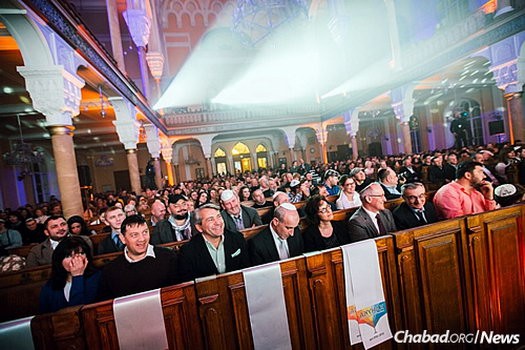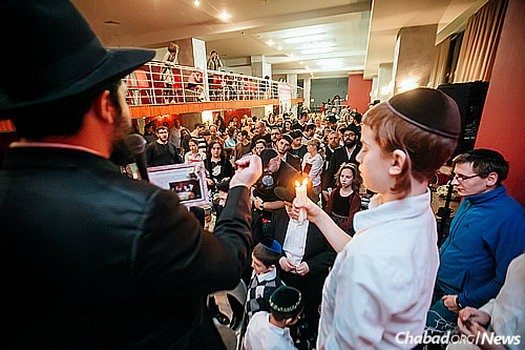
L’Chaim on a Moscow Train Platform: 25th Year Since the Fall of the USSR
First in a series of articles on Jewish life in the former Soviet Union in the 25th year since the formal dissolution of the USSR on December 26, 1991.
Three young Jewish men approached Reb Getche Vilensky’s Moscow apartment, hoping to join him that evening in celebrating the Chassidic holiday of 19 Kislev. It was the late 1950s; times were dangerous. In the building’s dark entryway lurked a Soviet policeman, waiting for them.
The young men—Notte Barkan, Yehuda Bartnovsky and Mottel Lifshitz—placed a call to their would-be host, Reb Getche, telling him “he had guests” (i.e., the police), and that they would not be able to join him that night for thefarbrengen they had hoped for.
“Reb Notte told me this story,” says RabbiYitzchak Kogan, himself a legendary figure in the underground Jewish community in Leningrad (today, St. Petersburg), and since 1991 the rabbi of the Chabad-LubavitchBolshaya Bronnaya Synagogue in central Moscow. “He said the three of them then took an electrichka trolley to the end of the line, to the last stop where all of the drunks used to congregate and split bottles of vodka between themselves. They got some herring, bought a bottle of vodka and sat the whole night among the drunks, singing and sharing Chassidic stories with each other. It was the only place they knew no one would be suspicious of them saying l’chaimtogether. That’s how they celebrated the 19th of Kislev.”
Kogan says many years later, Barkan, who after emigrating in 1969 returned to the USSR as a Chabad emissary to Riga, Latvia, in 1989, told him that it was that lonely Chassidic gathering on the dark and dingy outskirts of Moscow that gave the young men the strength and courage they needed to continue their work in the Soviet Jewish underground. The other two men—Bartnovsky and Lifshitz—also served the Moscow Jewish community with distinction, Lifshitz as the city’s shochet (ritual slaughterer) and mohel (circumciser).
It was this legacy of Russian-Jewish self-sacrifice that was highlighted at a massive 19th of Kislev farbrengenheld in Moscow on Nov. 29, where 1,000 people gathered at the opulent Congress Park at the Radisson Royal Hotel banquet hall to hear from, among others, former Soviet political prisoner and current head of the Jewish Agency for Israel NatanSharansky, former underground Chassidic activist Cantor BerelZaltzman and Kogan, who spoke via a video presentation.
“These are people who could have lived calmly and well had they just minded their own business, but they understood that this was not the Chassidic approach,” Rabbi Berel Lazar, Russia’s chief rabbi and head Chabad emissary, told the audience.
The Moscow gathering, which also drew Israel’s new ambassador to Russia Zvi Heifetz and Russian-Jewish literary figure Alexander Gelman, placed special emphasis on the fact that this December 26 marks the beginning of the 25th year since the dissolution of the Soviet Union
The renaissance of Jewish life and free religious practice throughout the former Communist empire is perhaps most visible during the week ofChanukah, when thousands of Jews gather to witness the lighting of menorahs in public squares throughout the former Soviet Union—inside the Kremlin in Moscow; on Kudirkos Square in Vilnius, Lithuania; across from the State Opera Theater in the center of Kharkov, Ukraine; and so many other places.
Yet the shimmering public lights of Chanukah—a Jewish holiday nearly forgotten by generations of Soviet Jews, only to be revived and reinvigorated in the last quarter-century—would not have been possible without the inner flame; without the furtive 19 Kislev Chassidic gatherings, subdued singing and disguised l’chaims of the past.
Jewish life had, of course, suffered unparalleled devastation during decades of Soviet rule, but it was not altogether destroyed. Using a spiritual jug of oil sealed by the Chabad Rebbes themselves, underground Chassidic activists had successfully ignited a lamp, one that continues to burn miraculously to this day.
A New Year of Light
The Chassidic holiday the young men marked on that lonely Moscow night in the 1950s—and the one that 1,000 people celebrated in grand style this month—is the 19th day of the Hebrew month of Kislev. Regarded within Chabad circles as the “New Year of Chassidism,” it celebrates the release of Chabad’s founder Rabbi Schneur Zalman of Liadi from a Tsarist Russian prison in 1798.
In addition to being the acknowledged leader of the Chassidic movement in Russia, White Russia, Lithuania and large swaths of Ukraine, Rabbi Schneur Zalman—also known as the Alter Rebbe—had founded the Colel Chabad charity to support needy Jews in the land of Israel, then under Ottoman rule. Jewish opponents of the Chassidic movement, both religious Jews and Jewish enlightenment activists from Vilna, used this information to bring accusations of treason against the Alter Rebbe to the government. They claimed that the money he collected for his charity was, in fact, aiding Russia’s enemy, the Ottoman Empire (the two countries had been at war throughout much of the 18th century). They hoped that by silencing this visionary Chassidic leader they could crush his burgeoning movement with one swift blow.
The Alter Rebbe was arrested and brought to St. Petersburg in a black iron wagon reserved for enemies of the state, and held in the Petropavlovskaya Fortress for 53 days. But the Alter Rebbe and his followers did not just see the charges only in physical terms; they saw it as a spiritual battle against the new teachings and path laid out by the Alter Rebbe. The charges were ultimately dropped by order of Tsar Paul I himself, and on the 19th of Kislev, Nov. 16, 1798 O.S., the Alter Rebbe was freed. The holiday is traditionally celebrated on both the 19th and 20th of Kislev, which corresponded this year to Dec. 1 through Dec. 2.
The holiday has been deeply ingrained in the Chassidic psyche ever since, its celebration marked each year with festive family meals, intimate farbrengensand large communal gatherings during which the story is retold, the Alter Rebbe’s famous melody of “Four Stanzas” sung, and l’chaims toasted.
“Grandfather visited us on the way to and from his Rebbe before Shavuot andRosh Hashanah,” wrote Israel’s President Zalman Shazar (1889-1974) regarding his childhood in Belarus. “On our part, we visited him during the weeks of Passover and Sukkot … and on the nineteenth of Kislev.”
(Shazar, who was named Schneur Zalman for the Alter Rebbe, came from Chabad roots on both his mother and father’s side).
In Russia, on the very same streets where the story’s events took place 217 years ago, there’s an intensified emotional connection to the day. For many Russian Jews from Chassidic backgrounds—even those who had strayed far from religious practice due to various circumstances—the 19th of Kislev remained an important holiday to mark in some way.
Sitting on the banks of the frozen Neva River, these days the Petropavloskaya Fortress in St. Petersburg is open to visitors. On display inside is a wax statue of the Alter Rebbe, one of the prison’s most famous former inmates, and near it hangs a sign: “Legend has it that Rabbi Schneur Zalman was visited in prison by Emperor Paul I himself. Each year, Rabbi Schneur Zalman’s followers come here to celebrate the day of his freedom.”
“Of course, there’s a special significance of celebrating 19th of Kislev in Petersburg today,” explains Rabbi Mendel Pewzner, who has been the city’s chief rabbi and head Chabad emissary since he moved to Russia with his wife, Sara, in 1992. “It’s explained that the real work of teaching Chassidus, spreading the Torah teachings that will lead to the coming of Moshiach, that began noch Peterburg, after the events of 19th Kislev in Petersburg. A new era of the Chassidic movement began then. So it’s very closely associated with this city.”
During Tsarist rule—save for a handful of wealthy and influential merchants and businessman—Jews were banned from living in St. Petersburg. The imperial city’s gates slowly opened to Jewish settlement during the reign of Tsar Alexander II (1855-1881), but Jews were not freely allowed in until after the Bolshevik Revolution, at which time Jewish religious practice began to be systematically suppressed.
Today, under Pewzner’s leadership, six Chabad Jewish centers operate throughout the city, including the Grand Choral Synagogue in the urban center. Some 500 Jewish students attend Chabad’s kindergarten-through-high-school educational system in St. Petersburg, which also counts ayeshivah and an orphanage.
“Every year on 19 Kislev, groups of children from our schools visit the fortress,” adds Pewzner. “That’s who the plaque is referring to.”
This year in honor of 19 Kislev—with the added emphasis of Hakhel, a once-every-seven-years occurrence that is a time traditionally dedicated to celebrating Jewish unity—the joint St. Petersburg Jewish community held a weekend Shabbaton retreat in a city suburb, drawing 300 men, women and children. There was also a large farbrengen held at the Choral Synagogue, barely a 10-minute car ride away from the fortress where the Alter Rebbe was held.
During the eight days of Chanukah, 20 large public menorahs shine proudly throughout St. Petersburg, with massive billboards informing passers-by of the menorah-lighting times—all of it seen by thousands of people each day. This in the city where it all began, where Chabad’s founder was imprisoned, tried and released, and who subsequently began a new phase of building the Chassidic movement and spreading its teachings.
It was the Alter Rebbe’s teachings and followers that would power Judaism’s survival during Russian Jewry’s darkest hour, as well as its eventual resurgence.
The Melody of ‘Four Stanzas’
If Kogan remembers a 19th of Kislev story dating to the 1950s, it’s because he experienced something similar, almost identical, 20 years later in Leningrad. Back at the Moscow gathering, a video was played of Kogan telling his own tale of a covert farbrengen celebrated years earlier.
“It was the 1970s, and I had read that there’s this Chassidic holiday and it’s called 19 Kislev,” says Kogan, repeating the story by phone from Moscow. “We had no idea how we were supposed to celebrate it, but I knew for sure you have to say l’chaim. In Leningrad there lived an old Tomim [a student of the Tomchei Temimim Lubavitch yeshivah system] named Reb Naftoli Hertz Chidekel, so we went to him.”
Kogan remembers climbing the stairs to Chidekel’s Leningrad apartment, friends in tow, bottle of vodka in hand.
“We knocked on the door saying, ‘Rav Chidekel, gut yontiff!’ He was an older man and he was a little afraid, but he opened up and responded in kind, ‘gut yontiff.’
“We told him that we had come to say l’chaim with him because it was the 19th of Kislev.”
Chidekel invited them in, looked first at their bottle and then at them, and said: “Don’t you know? On 19 of Kislev, you first sing the melody of the Alter Rebbe, and then you say l’chaim!”
Like 19 Kislev itself, the Alter’s Rebbe’s niggun [soulful Jewish tune], called “Daled Bavos” or the “Melody of Four Stanzas,” has a place of unparalleled importance for the Chabad follower. It is a serious and contemplative tune, one sung only on special occasions—under the chuppah at a wedding, during the High Holidays and on the 19th of Kislev. In teaching the song to Kogan and the other young men, Chidekel imparted to them the meaning of the day.
“The melody of the Old Rebbe [Alter Rebbe] is rooted in the soul of every Chabad Chassid, and his children and children’s children until the end of the generations,” Shazar records his pious Chassidic grandfather telling him during their last ever encounter. “If a righteous Chassid or any one of his descendants wants to remember this holy melody and it escapes him no matter how hard he tries to recall it, this simply proves that at that particular time he has deviated somehow from the true path and must search his soul and repent.
“It cannot be for nothing, my child, that a Chassid forgets the Rebbe’s melody—this precious gift and touchstone. Do not lose it, my child!”
A Continuous Miracle
This year will mark 25 years since the fall of the Iron Curtain, the precipitous disintegration of Soviet power that few analysts predicted even towards the end of the 1980s. The happy anniversary is not lost on the Jewish community of Russia, which plans on marking it with a series of events throughout the coming year, beginning with this month’s 19th of Kislev banquet in Moscow.
“Only 25 years have gone by since that year that the Rebbe [the Lubavitcher Rebbe, Rabbi Menachem M. Schneerson, of righteous memory] said, ‘Let this be a year of miracles,’ ” recounted Lazar during his speech at the banquet. “We all remember how these miracles changed circumstances, specifically in this country. Since that time the Jewish community has grown, authorities look at the community differently, and thousands and thousands of Jews are returning to their roots and tradition—the miracle has continued until this day.”
“But like any miracle, it is possible thanks to people who are ready to sacrifice of themselves—that’s how it was on Chanukah, that’s how it was on Purim, and that’s how it is in our times. In this hall today, there are a number of people that, thanks to them, we are able to celebrate this holiday again.”
Zaltzman, a guest speaker flown in from the United States, was one of those people. Born and raised in the Soviet Union, he had been a member of the Chabad community in Samarkand, Soviet Asia, where until the early 1970s a full-fledged Chassidic infrastructure secretly flourished. Zaltzman grew up without ever stepping foot into a Soviet school, which meant he spent large parts of the school year in a closet or basement, hiding.
When he was a teenager and developed an operatic singing voice, he told his father he wanted to enroll in a musical school in Samarkand.
“I told my father I have no diploma, no skills, why shouldn’t I go train my voice here? I’ll become a chazzan[cantor] when we get to Israel,” Zaltzman told the audience in Moscow. “My father answered me, ‘Before you become a chazzan, you will become a non-Jew!’
“That’s how my father saw it,” said Zaltzman. “There could not be any compromises.”
Sharansky spent close to nine years behind bars and in Gulag labor camps before being released in 1986. He spoke of the isolation room at the Lefortovo Prison in Moscow and visiting it years later, before telling the audience of the person who informed his wife, Avital, that he would soon be going free: The Rebbe.
“Then came the day, the Rebbe’s secretary Rabbi [Binyomin] Klein called my wife and told her that this time they would be releasing me,” Sharansky recalled. “And that’s what happened. There was a day that I woke up in Lefortovo prison … and that evening I was with my wife and the whole nation of Israel at the Kotel [Western Wall].”
Just five years later, the miraculous changes that had allowed Sharansky to be freed had swept through the Soviet Union. That Chanukah, 1991, thousands of Jews gathered at the Kremlin Palace of Congresses to take part in the lighting of the menorah, which was broadcast around the world as part of the “Chanukah Live” program that linked world-wide menorah-lightings via satellite, including the one with the Rebbe in New York.
On the stage were the Rebbe’s new emissaries to the Soviet Union (which would formally break apart officially weeks later), Lazar, in Moscow, and Rabbi Shmuel Kaminezki, who had recently settled in Dnepropetrovsk (today, Ukraine). But the menorah was lit by an elderly man with a booming voice and a wooden leg named Reb Avraham Genin, a veteran underground Chabad activist who had spent decades working to sustain Jewish life in the Soviet Union. He read the blessings loudly and clearly; the public lighting of a menorah was the culmination of decades of dangerous work for the Jewish community at large.
Genin passed away not long thereafter.
“I remember very clearly a secret 19th of Kislev farbrengen of Lubavitcher Chassidim here in Moscow,” said Lazar during his speech. “And they were discussing: ‘What more can we do? How can we further spread Torah and Judaism, so that every Jew can find a path home?’”
The Chassidic teachings and spirit that stemmed from the Alter Rebbe and were continued by his successors, explained Lazar, was the secret not only to the chassidim’s survival, but their dedication to expanding the work.
“They were just a handful of people, but like the Previous Lubavitcher Rebbe [Rabbi Yosef Yitzchak Schneersohn, of righteous memory], said: ‘Although our army may be small in numbers, it is battle-ready.’”

